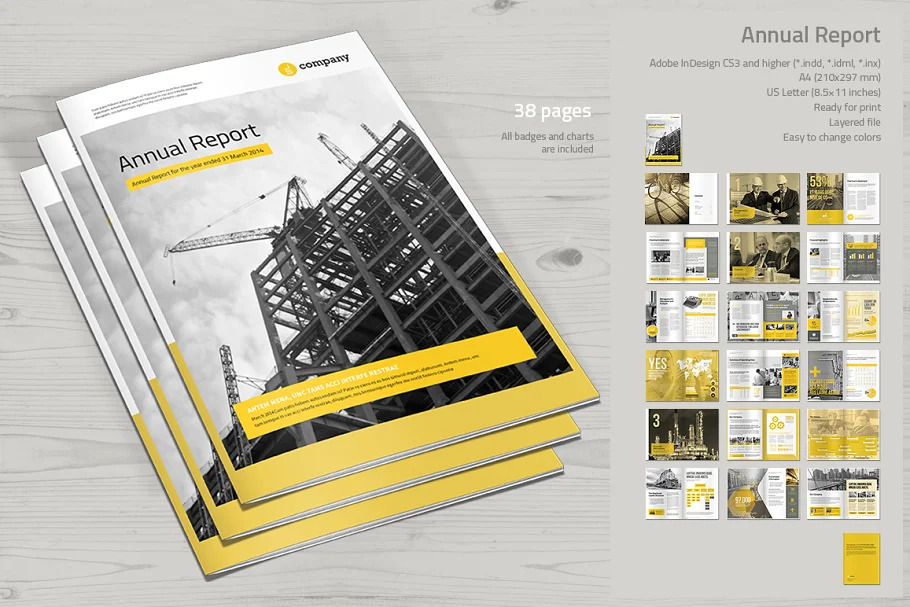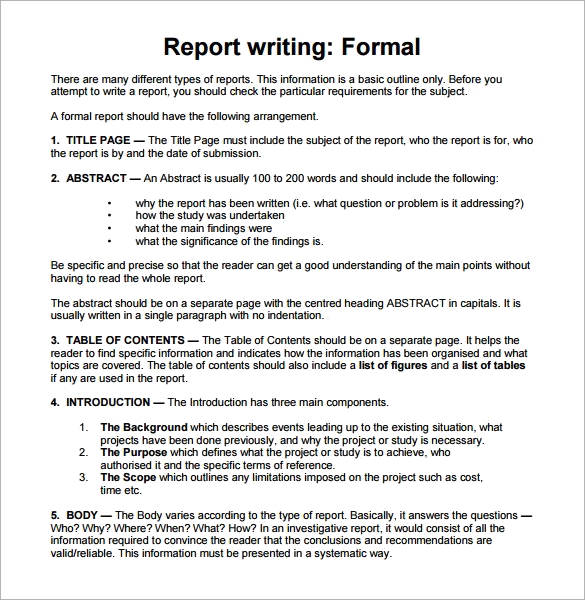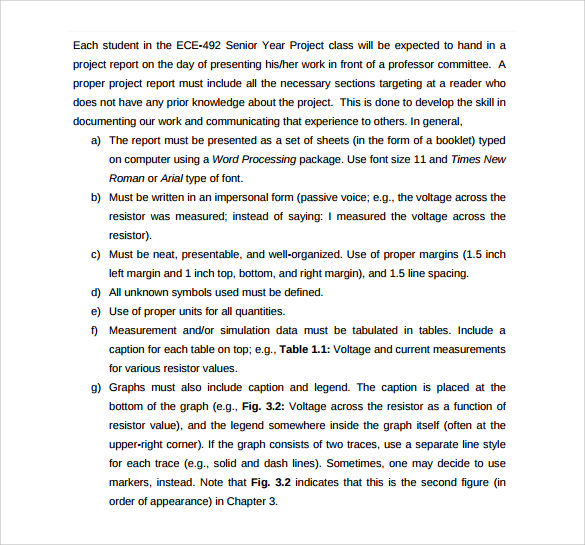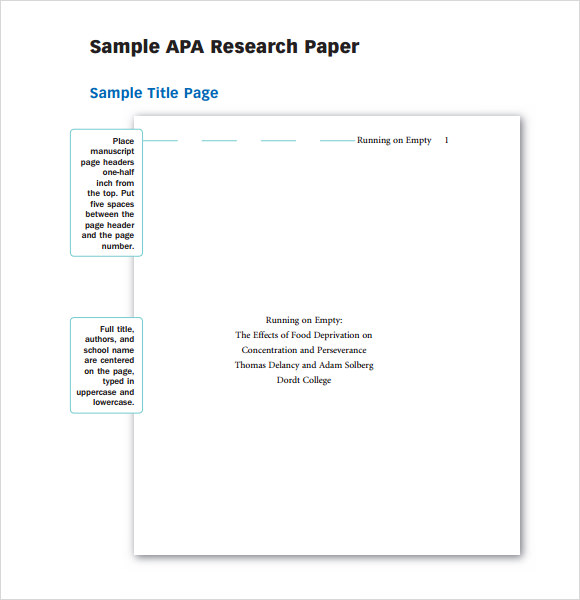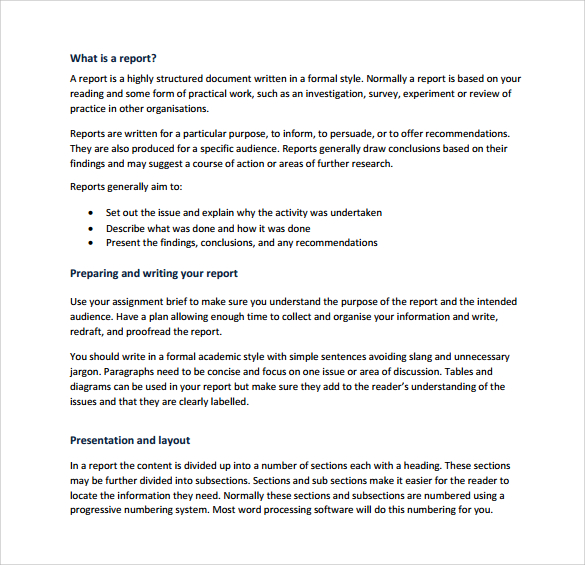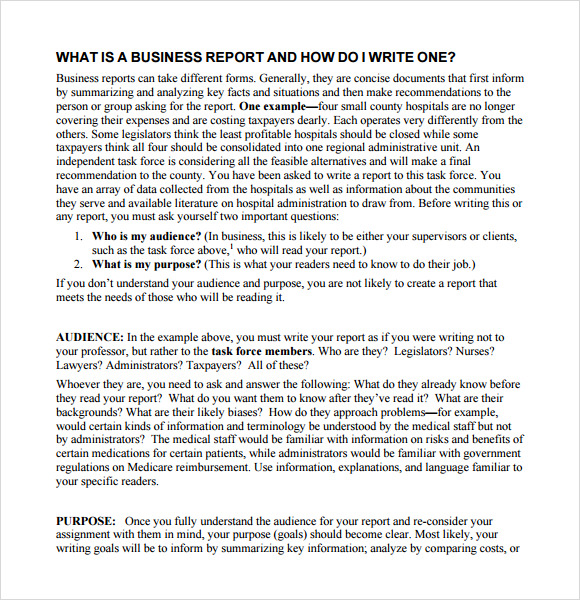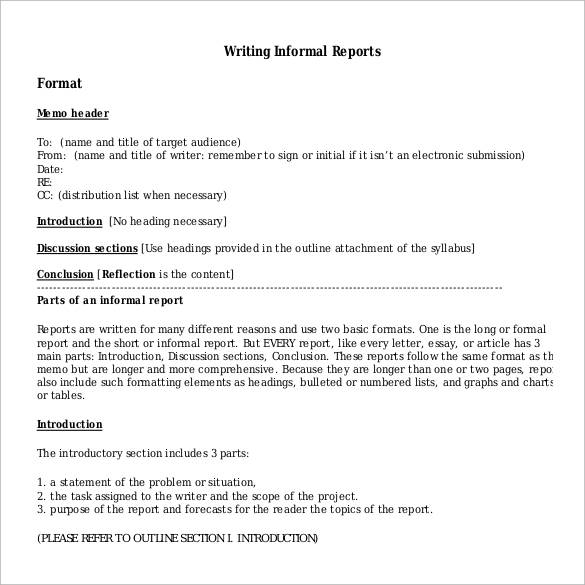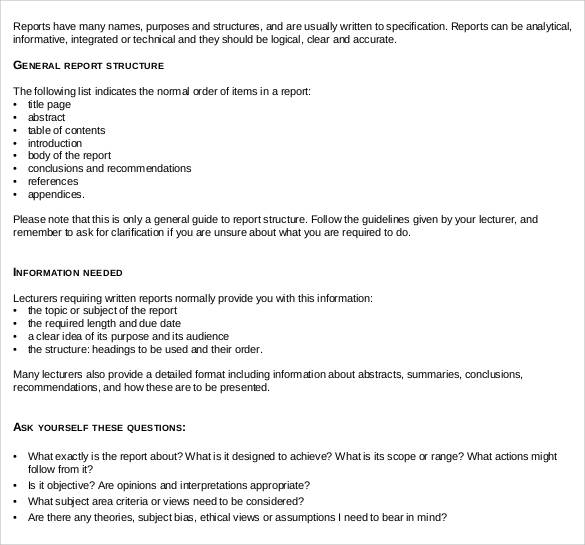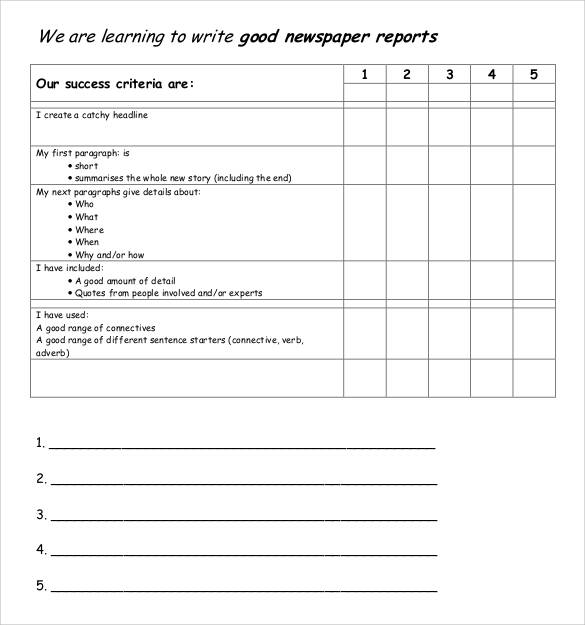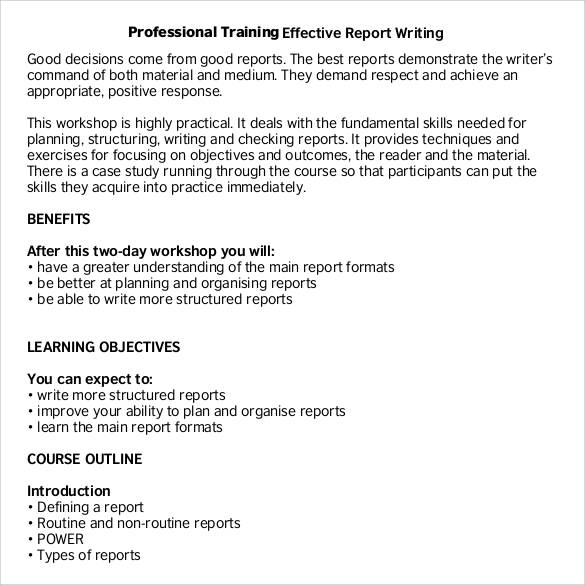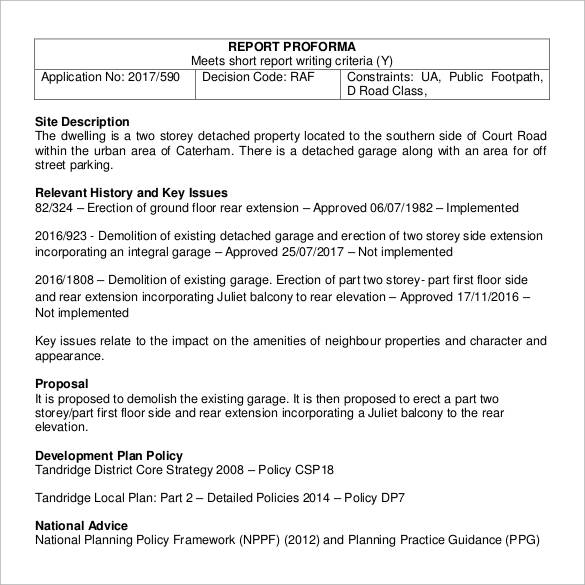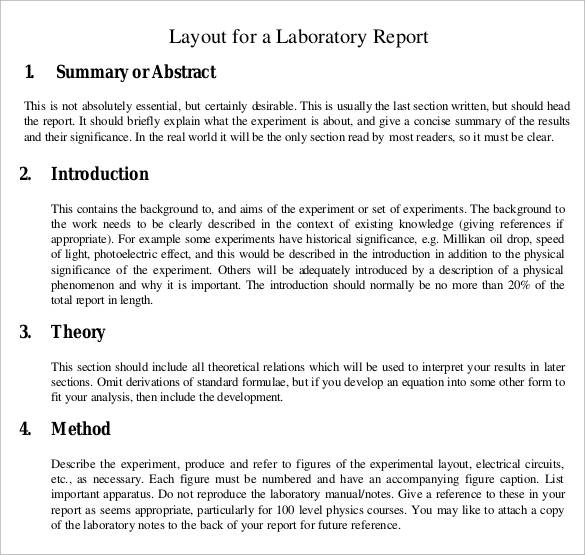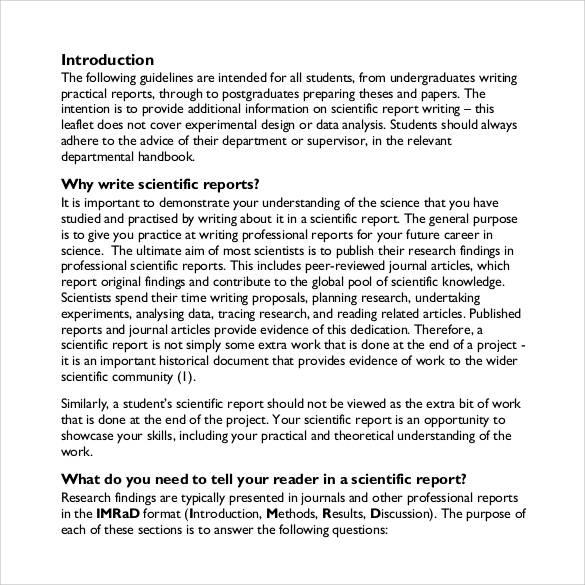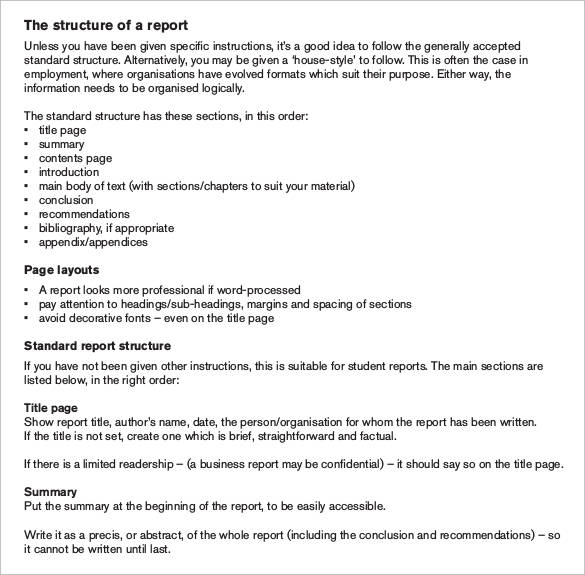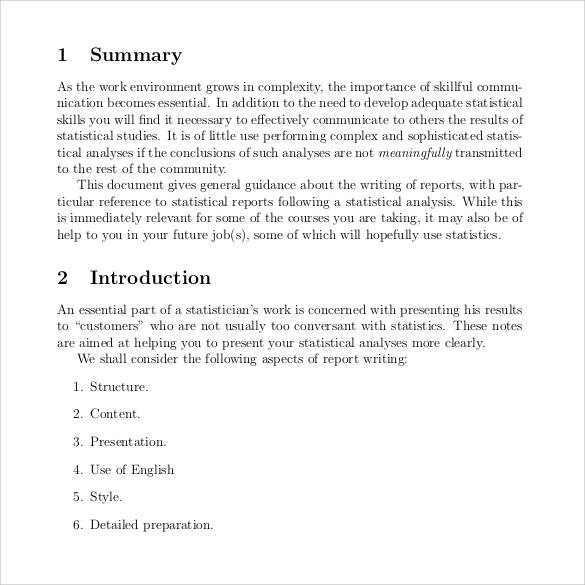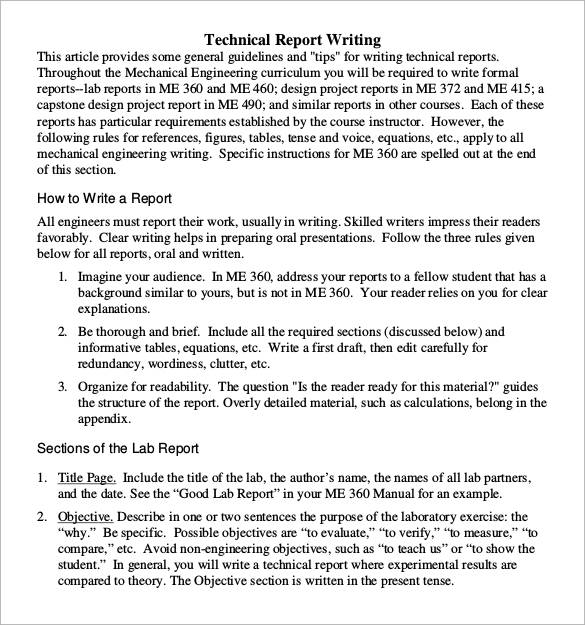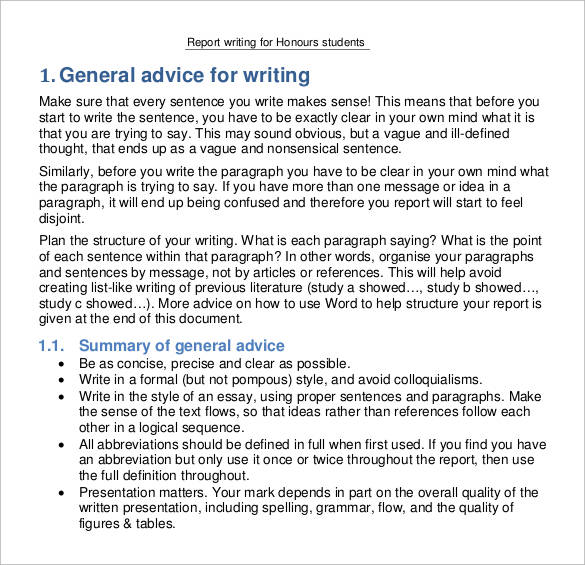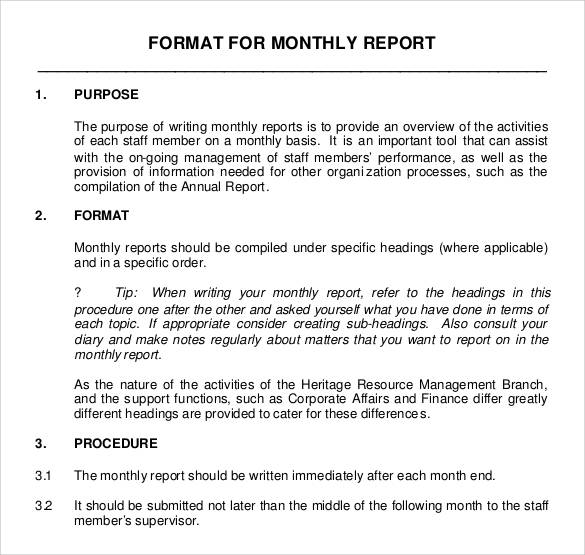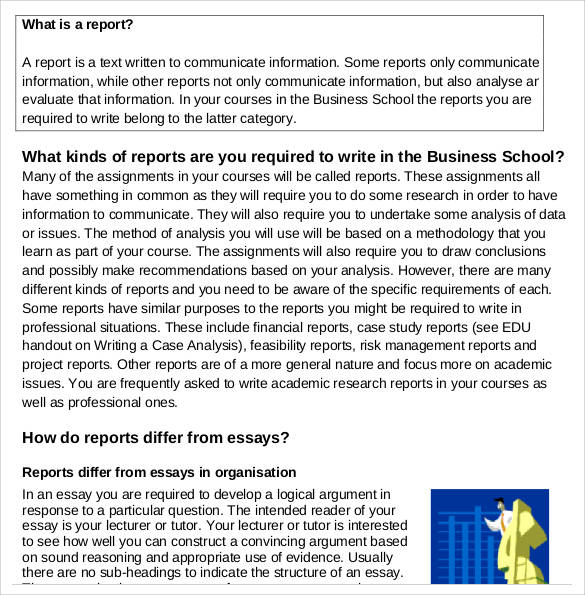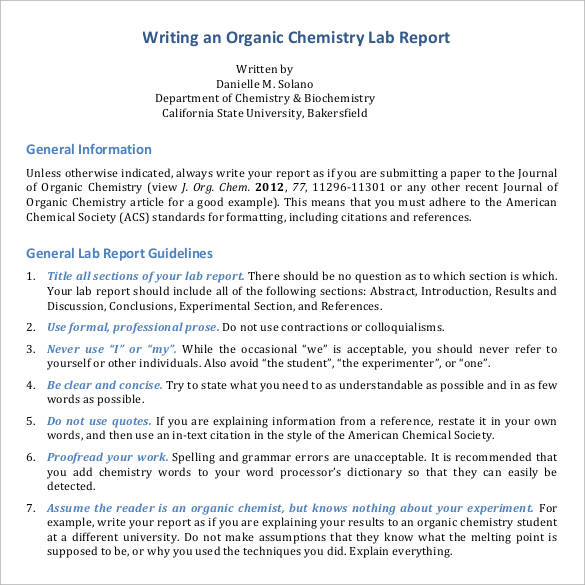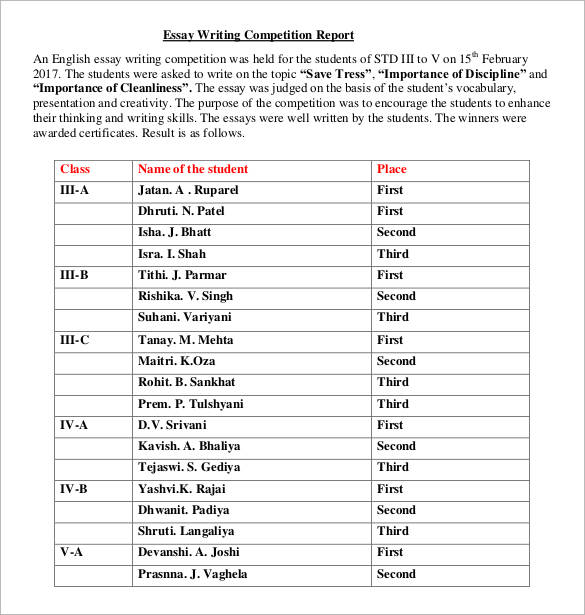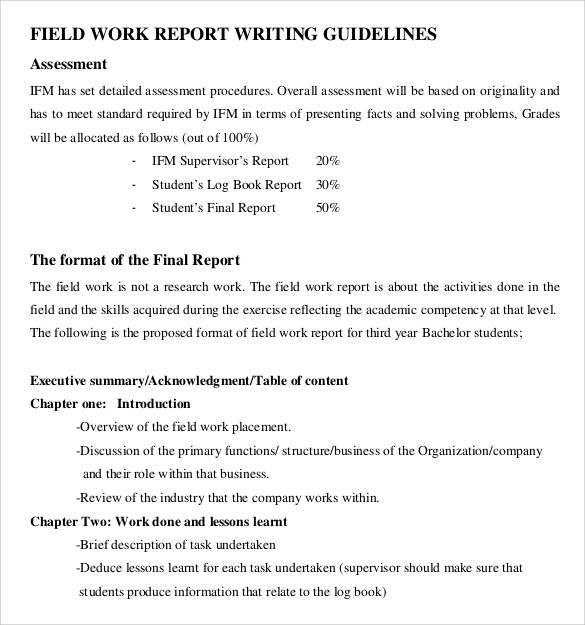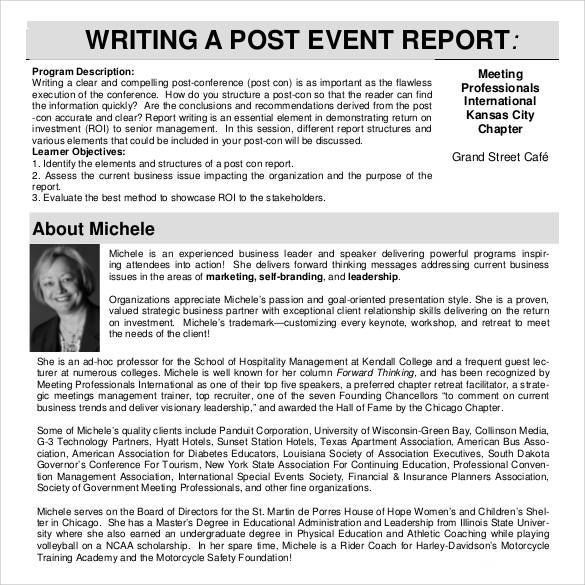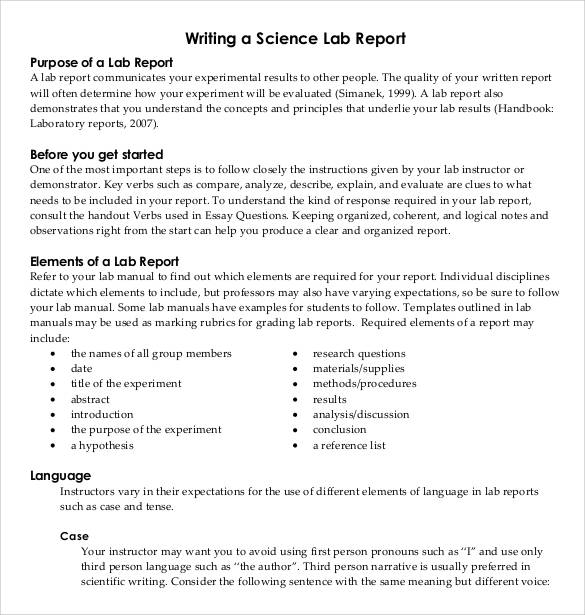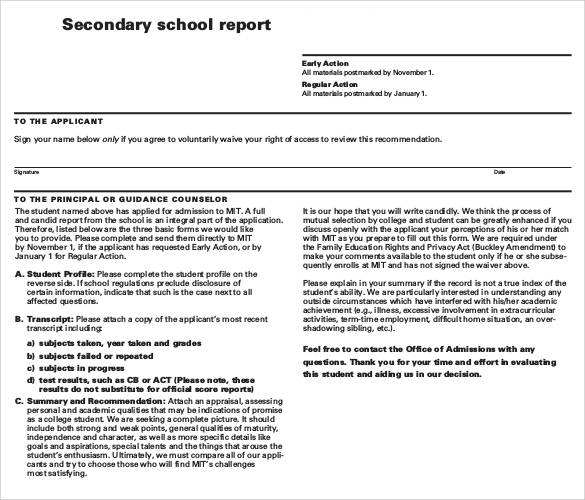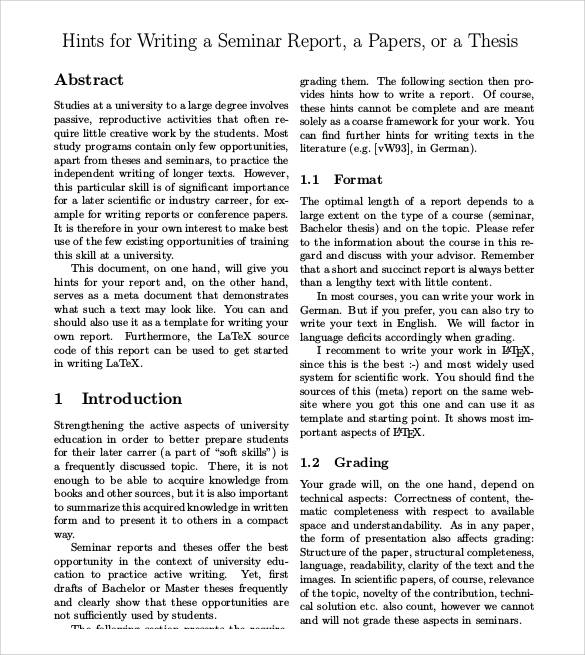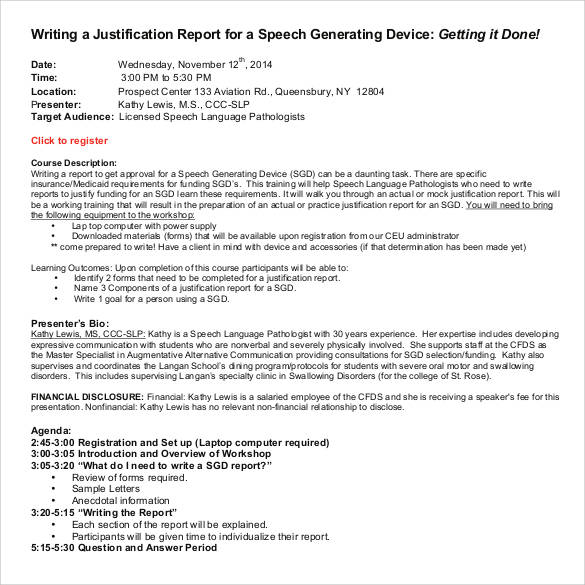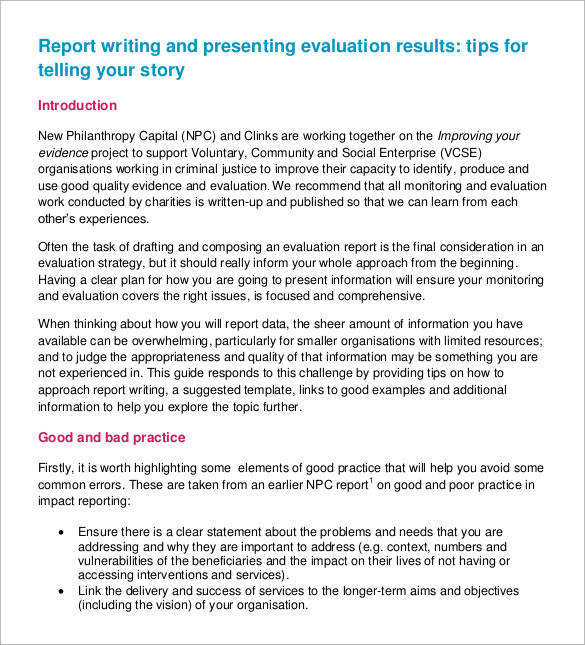Report writing format differs from one subject or category in the academic, but all through out, one thing is common to them, they present all the facts collected in an organized manner and maintains the formality of writing the content of the report writing from the space, fonts and arrangement that must be followed for each subject or categories. This layout tool will give any college or school students or a person the correct legal Complaint Letter Format Template in writing their reports and the contents they must include being able to complete it. You may like professional report.
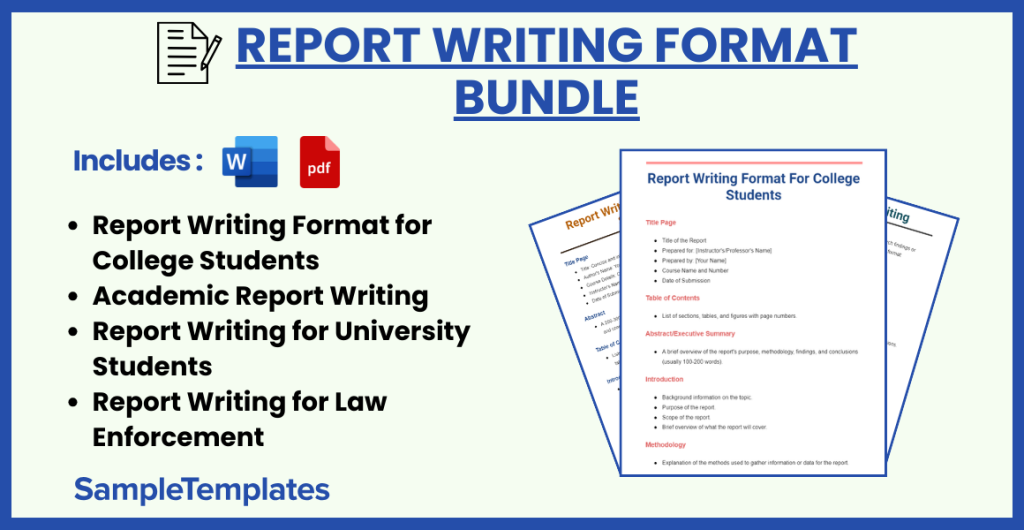
Download Report Writing Bundle
Report Writing Format for College Students
Title Page
- Title of the Report
- Prepared for: [Instructor’s/Professor’s Name]
- Prepared by: [Your Name]
- Course Name and Number
- Date of Submission
Table of Contents
- List of sections, tables, and figures with page numbers.
Abstract/Executive Summary
- A brief overview of the report’s purpose, methodology, findings, and conclusions (usually 100-200 words).
Introduction
- Background information on the topic.
- Purpose of the report.
- Scope of the report.
- Brief overview of what the report will cover.
Methodology
- Explanation of the methods used to gather information or data for the report.
- Description of any tools, techniques, or approaches utilized.
Findings/Results
- Presentation of the data or information found during research.
- Use of charts, graphs, or tables to illustrate key points.
Analysis/Discussion
- Interpretation of the findings.
- Discussion of how the results relate to the topic or research questions.
- Any unexpected results and possible explanations.
Conclusion
- Summary of the main findings and analysis.
- How the findings address the report’s purpose.
Recommendations (if applicable)
- Suggestions for action based on the findings and analysis.
- Could be directed at specific groups or individuals.
References
- List of all sources cited in the report, formatted according to the appropriate academic style guide (e.g., APA, MLA).
Appendices (if necessary)
- Additional material that supports the report’s content (e.g., raw data, detailed analyses, full survey/questionnaire).
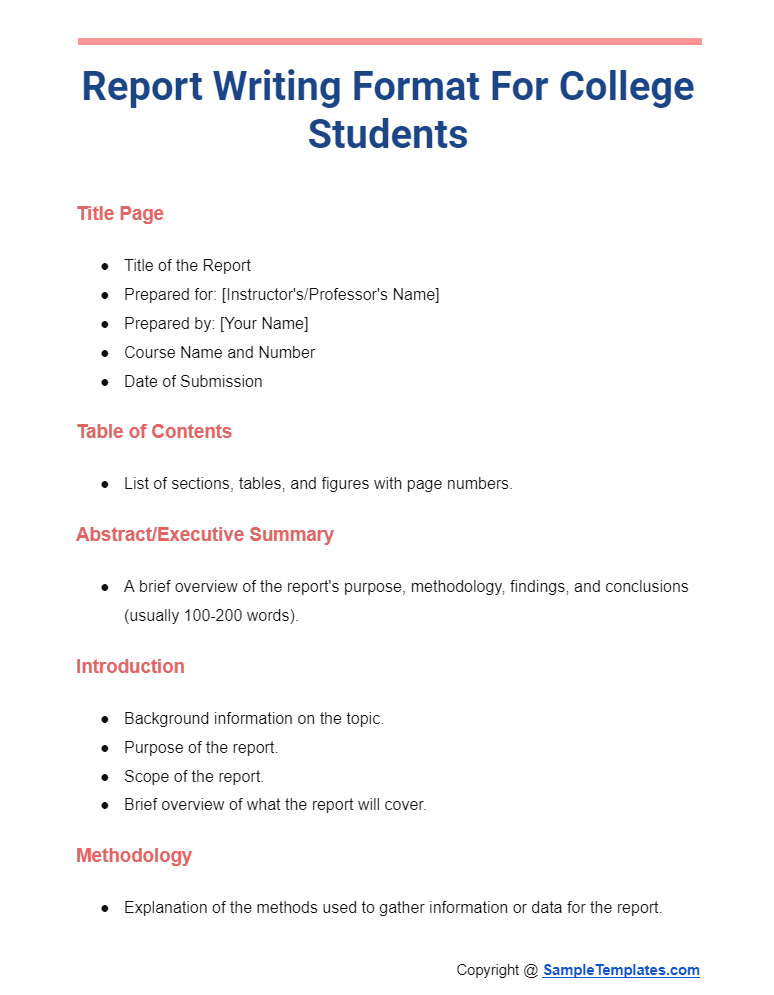
Academic Report Writing
Academic report writing involves a structured format to convey research findings or analyze a specific topic or issue. Here’s a comprehensive guide to the format:
Title Page
- Title of the Report: Concise and descriptive.
- Author’s Name: Your name or the group members’ names.
- Course Name: The course for which the report is being submitted.
- Instructor’s Name: The name of your professor or instructor.
- Submission Date: The date the report is submitted.
Abstract (or Executive Summary)
- A brief overview of the report’s purpose, methodology, findings, and conclusions. Usually about 200-300 words.
Table of Contents
- Lists the report’s main sections and their page numbers for easy navigation.
Introduction
- Introduces the topic, provides background information, states the purpose of the report, and outlines the report structure.
Methodology (or Methods)
- Describes the research methods used to gather data. This could include surveys, experiments, or literature reviews.
Results (or Findings)
- Presents the data or information found during research. Use charts, graphs, or tables to illustrate key points.
Discussion
- Interprets the results, explaining what they mean in the context of the topic. Discusses the implications of the findings and any limitations of the study.
Conclusion
- Summarizes the report, reiterates the main findings, and suggests recommendations or further research areas.
References (or Bibliography)
- Lists all the sources cited in the report. Ensure to follow the specified citation style (APA, MLA, Chicago, etc.).
Appendices
- Includes additional materials related to the report, such as raw data, detailed tables, or questionnaires. Each appendix should be labeled and referred to in the main text.
Additional Tips:
- Clarity and Precision: Use clear, concise language and avoid jargon or colloquialisms. Be precise in your descriptions and explanations.
- Evidence and Support: Back up your claims with evidence from your research. Cite your sources accurately.
- Formal Tone: Maintain a formal, academic tone throughout the report.
- Proofreading: Thoroughly proofread your report for spelling, grammar, and punctuation errors before submission.
Academic report writing is a critical skill that demonstrates your ability to analyze and communicate complex ideas. Following this structured format will help ensure your report is clear, coherent, and professionally presented.
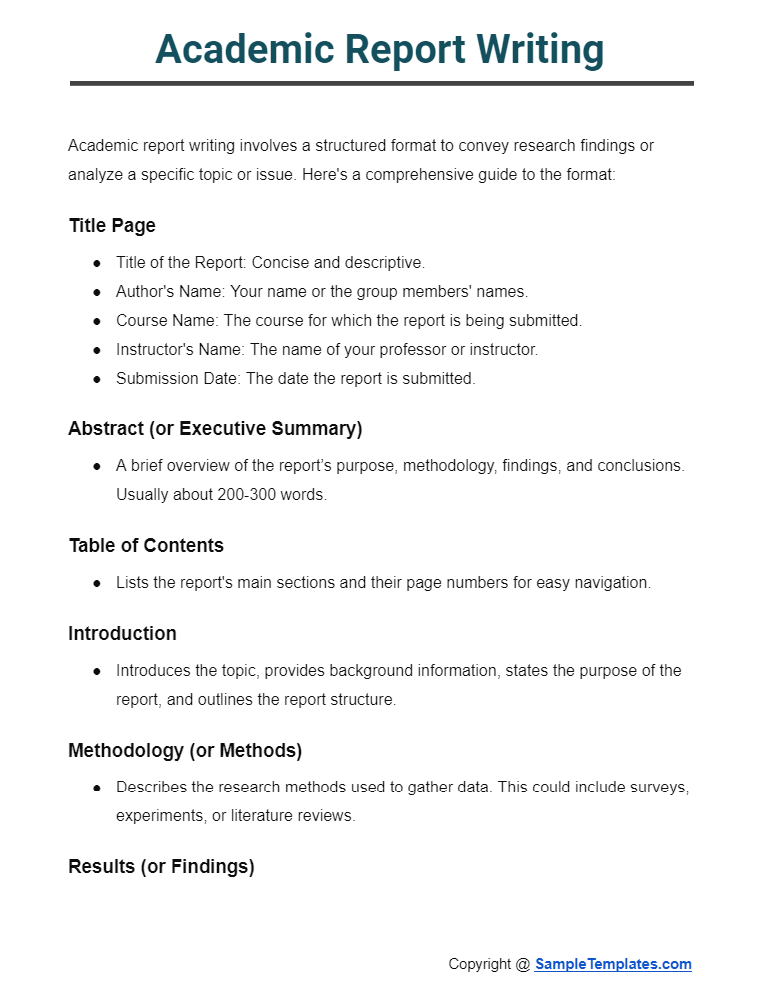
Report Writing for University Students
Title Page
- Title: Concise and informative.
- Author’s Name: Your full name.
- Course Details: Course code and name.
- Instructor’s Name: Full name of your lecturer or supervisor.
- Date of Submission: Ensure this is accurate.
Abstract
- A 200-300 word summary of your report’s objectives, methodology, key findings, and conclusions. It should be clear and standalone.
Table of Contents
- Lists sections, sub-sections, and page numbers. Include lists of figures and tables if applicable.
Introduction
- Introduce the topic, background information, and the purpose of the report. Outline the questions or hypotheses addressed and give a brief overview of the report’s structure.
Literature Review (if applicable)
- Summarize and evaluate existing research relevant to your topic. This section demonstrates your understanding of the subject area and contextualizes your work.
Methodology
- Describe how you conducted your research. Include details about data collection methods, participants, and processes. This section should be detailed enough for someone to replicate your study.
Results or Findings
- Present the data collected during your research. Use tables, graphs, or charts to illustrate key points. Be objective and refrain from interpreting the data in this section.
Discussion
- Interpret the results, explaining their implications in the context of your research question or hypothesis. Discuss any patterns, anomalies, or unexpected findings. Compare your results with the literature reviewed earlier.
Conclusion
- Summarize the main findings, their relevance, and the broader implications. Suggest recommendations for future research or practical applications based on your findings.
References
- List all sources cited in your report. Adhere to the required citation style (APA, MLA, Chicago, etc.).
Appendices
- Include any supplementary material (detailed tables, questionnaires, additional data). Each appendix should be labeled and referenced in the main text.
Writing Tips:
- Clarity and Precision: Use clear, concise language. Avoid unnecessary jargon.
- Evidence-Based: Support your arguments with data or citations from credible sources.
- Formal Tone: Maintain a formal academic tone throughout the report.
- Consistency: Be consistent with formatting, citation style, and terminology.
- Proofreading: Review your report for spelling, grammar, and factual errors. Consider peer review for additional feedback.
Writing a university report requires careful planning, research, and a clear understanding of the topic. By following this structured approach, you can effectively communicate your findings and contribute valuable insights to your field of study.
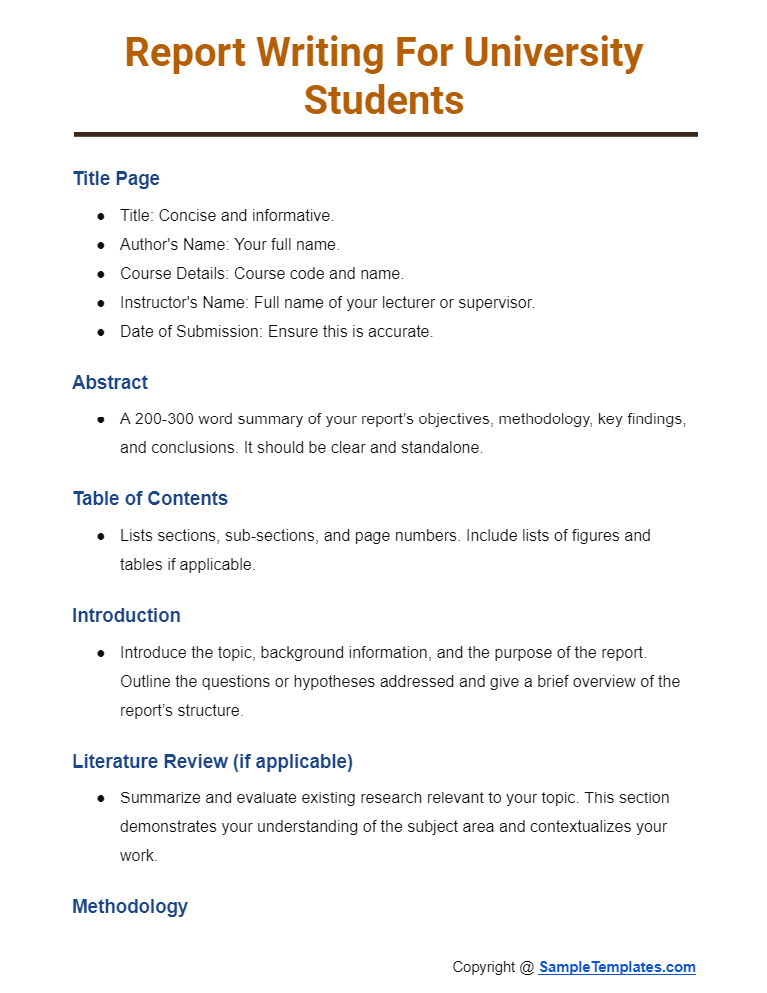
Report Writing for Law Enforcement
Report writing in law enforcement is a critical skill, as these reports serve as official records that may be used in investigations, legal proceedings, and policy development. Here’s a format commonly used in law enforcement report writing:
Heading
- Report Title: Indicate the type of incident (e.g., Theft Report, Traffic Accident Report).
- Report Number: Unique identifier for the report.
- Date and Time of Report: When the report is being written.
- Location: Specific location of the incident.
- Reporting Officer: Name and badge number of the officer writing the report.
Introduction
- Date, Time, and Location of the Incident: Precise details about when and where the incident occurred.
- Reporting Party: Information about the individual who reported the incident, including name, address, and contact details.
- Victims/Witnesses: Names and relevant information of victims or witnesses, if applicable.
Incident Description
- Nature of the Incident: A detailed description of what happened. Start with a summary of the incident, followed by a chronological account.
- Actions Taken: Steps taken by law enforcement at the scene or in response to the incident.
- Evidence Collected: List of evidence collected at the scene, if any.
Observations and Findings
- Officer’s Observations: Detailed observations made by the reporting officer or other law enforcement personnel at the scene.
- Initial Findings: Preliminary conclusions based on the investigation at the scene.
Conclusion and Next Steps
- Conclusion: Summarize the current status of the investigation or report.
- Follow-Up Actions: Outline planned or recommended follow-up actions or investigations.
Attachments
- Photographs: Include or reference any photographs taken at the scene.
- Documents: Reference any additional documents attached to the report, such as witness statements.
Signature
- Officer’s Signature: The report should be signed by the reporting officer.
- Reviewing Officer’s Signature: If reviewed by a superior, include their signature as well.
Tips for Effective Law Enforcement Report Writing:
- Clarity and Accuracy: Use clear, concise language. Ensure all details are accurate and factual.
- Objectivity: Maintain an objective tone, avoiding assumptions or subjective judgments.
- Detail-Oriented: Include all relevant details, no matter how minor they may seem. Specificity is crucial for the utility of the report.
- Use of Plain Language: Avoid excessive use of jargon. When technical terms are necessary, provide definitions.
- Chronological Order: Present information in the order it occurred to maintain clarity and coherence.
- Confidentiality: Be mindful of sensitive information and adhere to departmental guidelines regarding confidentiality and information sharing.
Remember, law enforcement reports are legal documents. The information provided must be thorough and precise, as these reports can be scrutinized in court or used in ongoing investigations.
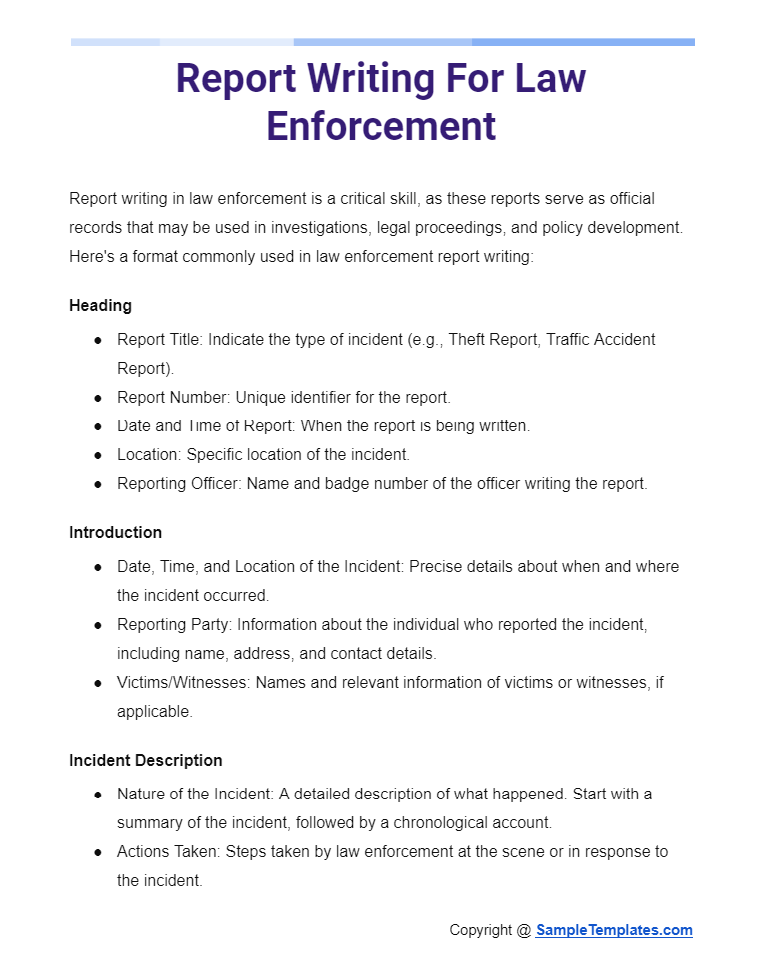
Browse More Templates On Report Writing
Sample of Report Writing PDF
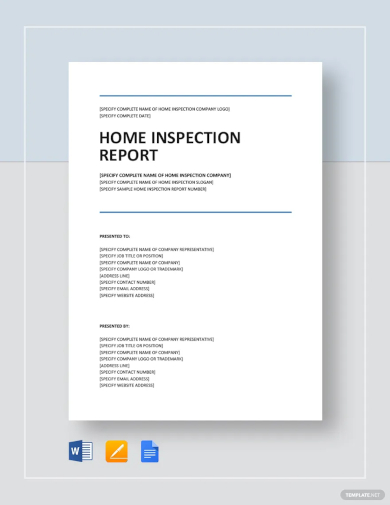
Report Writing Format
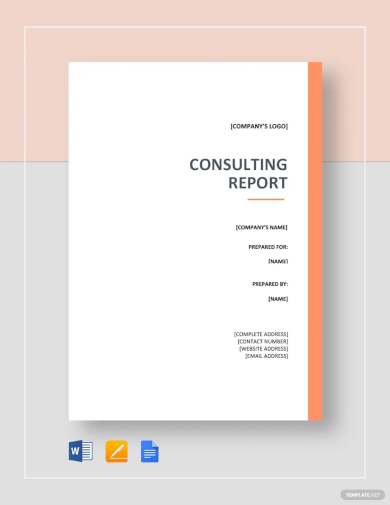
Report Writing Template
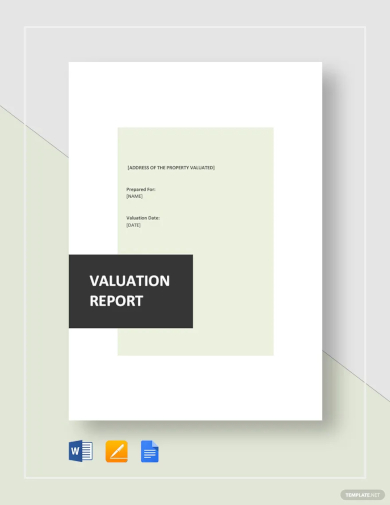
Example of Report Writing
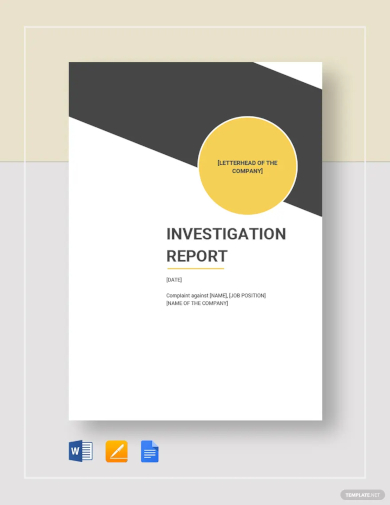
Simple Report Example
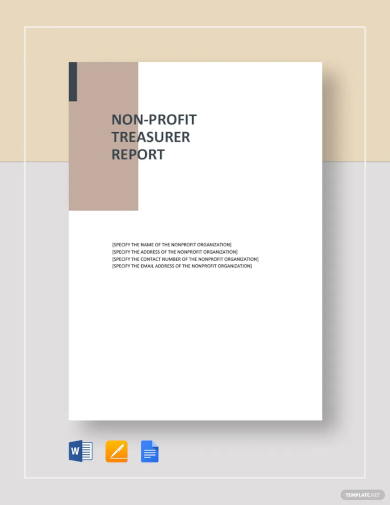
You can search a lot of free formats in report writing in the internet, you just need to choose the suitable document format for your usage which can be also downloaded or printed. Basic Report writing format will assure you that you will never experience any hustle in completing your report as it will give you the arrangements you need to follow. You can also see company report templates.
Sample of Report Writing PDF Download
Report Writing Examples
This is a template for formal method of report writing. It shows the right method to follow and order of subheadings to be included. A formal report should have the subheads – title page, abstract, table of contents, introduction, and body in the same order.
Report Writing Sample for Students – PDF
This template shows the sample report writing format for students. It gives a complete detail about what information should be included and what should not be there. You will find the report structure, the suggested standard format, the background and an example of a students’ report.
Simple Report Format Example
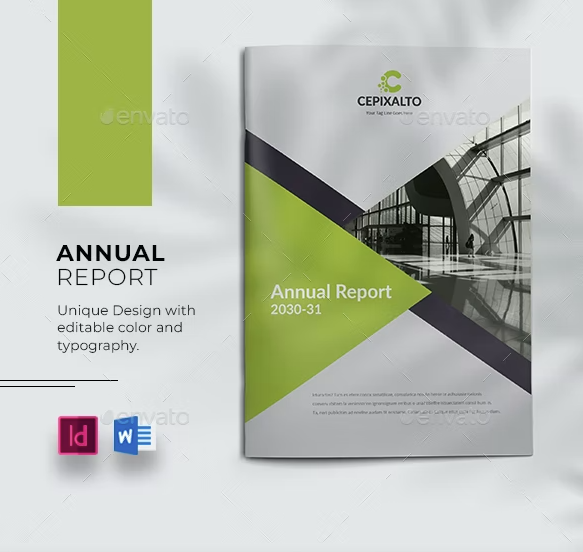
graphicriver.net
How to Write a Report Example PDF
If you are looking for a format to write a project report, you must download this template. It tells in detail what sections of information must be included in the report, from a reader’s point of view. Here you will find all the guidelines required.
Formal Report Writing Sample PDF
This template shows the method in which an APA research paper should be written. It gives the right instructions to be followed while writing a research paper. All you need to do is download this template and write your paper as per the specified guidelines.
Report Writing Format PDF Download
How to Write a Report Sample
Report Writing Samples
What are the 5 Steps in Report Writing?
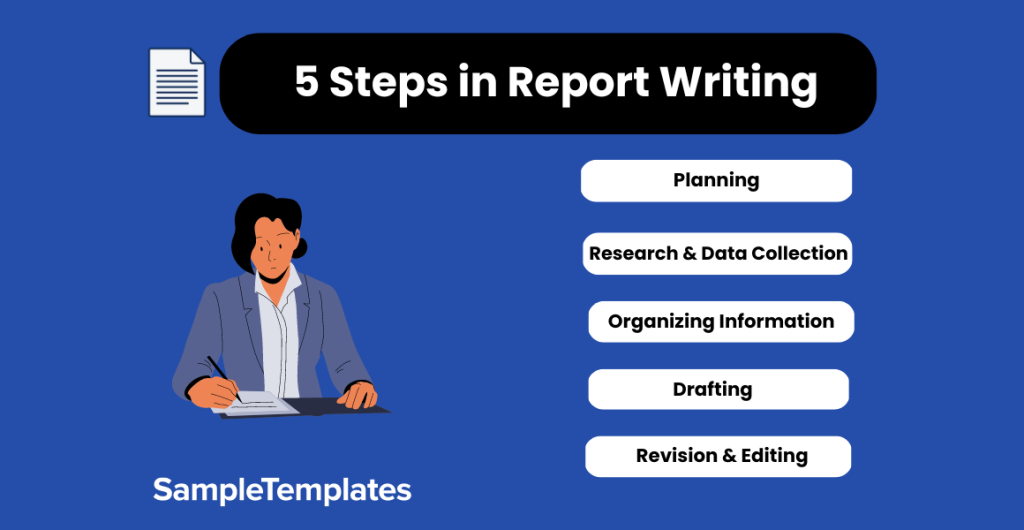
- Planning: Define the purpose, scope, and audience of the report, outlining key objectives and the structure.
- Research and Data Collection: Gather relevant information, facts, and data to support the report’s content.
- Organizing Information: Structure the report logically, with a clear introduction, body, and conclusion. Use headings and subheadings for clarity.
- Drafting: Write the first version of the report, ensuring coherence, consistency, and adherence to the defined structure.
- Revision and Editing: Review and refine the report for clarity, conciseness, and accuracy, addressing any errors or inconsistencies.
Example of Report Writing PDF
Report Structure Template
Tips for Writing Reports

Report writing is an integral part of every employee’s task. It comprises of the details of the tasks completed by him, goals met and the benefits brought in to the company. Thus, it is always a great idea to look into some report writing specimens to get the format right. Here are some tips that would also be of help.
- Be Clear and Concise: Use simple language and avoid unnecessary jargon. Your report should convey information easily and quickly to the reader.
- Use an Objective Tone: Maintain neutrality and objectivity. Present facts and evidence without letting personal opinions influence the report’s content.
- Start with a Summary: Begin with an executive summary or abstract that outlines the main points, findings, and conclusions of the report. This helps readers understand the key elements before diving into details.
- Structure Your Report: Organize your report into clear sections with headings and subheadings. Common sections include Introduction, Methodology, Findings, Discussion, Conclusion, and Recommendations.
- Incorporate Visuals: Use charts, graphs, and tables to present data visually. This can make complex information more digestible and engaging for the reader.
- Cite Your Sources: Provide citations for all referenced work to enhance the credibility of your report. Follow the appropriate citation style as required by your field or organization.
- Proofread and Edit: Review your report for spelling, grammar, and punctuation errors. Also, check for clarity, coherence, and logical flow of information. It’s often helpful to have someone else review your work.
- Appendices for Additional Information: Use appendices to include detailed data, questionnaires, or other relevant materials that support your report outline but would clutter the main text.
Following these tips will help ensure that your reports are effective, professional, and valuable to your audience.
Newspaper Report Writing Template
Report Format
Professional Training Report Writing Template
What are the Main Components of Report Writing?
- Title Page: Clearly stating the report’s title and authorship.
- Abstract/Executive Summary: Providing a concise overview of the report.
- Introduction: Presenting the purpose, scope, and context of the report.
- Methods/Procedures: Detailing the approach taken in gathering and analyzing information.
- Findings/Results: Presenting the main outcomes or discoveries.
- Discussion/Analysis: Interpreting and analyzing the findings in context.
- Conclusion: Summarizing key points and suggesting any recommendations.
- Recommendations: Offering suggestions or actions based on the findings.
- References: Citing sources used in the report.
- Appendices: Including supplementary materials, charts, or additional data.
Proforma Report Writing Template
Layout of Report Examples
Purpose of Report Writing Format
When writing a report, it is extremely important to present it in the pattern that is approved by the organization and the industry as a whole. Though a lot of companies have special applications to generate reports, the others have to make do with the report models that are available online. Let us take a look at the purpose of report writing format.
- It gives you an idea of the format to be followed.
- It comes in handy to decide on the important sections that should be included in the report.
- Since it is designed by experts, it adheres to the industry trends and thus helps the user to design an impressive and effective report. You may also see analytical report writing.
- It can be used to create reports for all kinds of industries and organizations irrespective of their operations and their products. You may also see technical reports.
Scientific Report Writing Template
Standard Report Structure Writing Template
Statistical Report Writing Template
Technical Report Writing Format Template
Simple Report Writing Examples for Students – PDF
How do you write a Research Report?
Whether you have researched to write an article or to study about rural development, you must compile a proper research report which you can then submit to the higher officials. A lot of educational institutions also encourage their students to write a research report post a study tour. Here is how you can write such a report.
- Start with the introduction where you need to give a brief account of the topic.
- This should be followed by abstract description of the topic with all the samples and designs furnished. You may also see report writing formats.
- Next talk about the methodologies and techniques used by you to conduct the research.
- This should be followed by the result that you deduced from the research. You may also see technical reports sample.
- In the end, discuss the topic of offering information from every point of view. Conclude the report with a summary. You may also see formal reports.
Monthly Report Format
Internship Weekly Report Form Template
School Report Writing Format PDF
Chemistry Lab Report Writing Template
Essay Writing Competition Report Template
Types of Report Formats
Report writing can be adapted to various formats depending on the purpose, audience, and content. Here are some common types of report formats:
- Formal Reports: These are detailed and structured documents often used in business, academia, and government. Formal reports might include components like a title page, table of contents, executive summary, introduction, methodology, findings, conclusions, recommendations, and appendices.
- Informal Reports: Typically shorter and less structured than formal reports, informal reports are used for routine communication within organizations. They may be in the form of memos, emails, or letters and usually focus on reporting on actions, tasks, or progress.
- Technical Reports: Used to convey technical information and analysis about products, processes, or experiments. These reports include detailed descriptions of methods and materials, results, and conclusions. They often contain technical terminology and data visualizations.
- Research Reports: These are comprehensive accounts of research projects. They detail the research question, literature review, research methodology, data analysis, findings, and conclusions. Research reports are common in academia and various industries for sharing new knowledge and insights.
- Business Reports: Aimed at providing an analysis of business-related issues, these reports guide decision-making processes. They might cover market research, financial analysis, feasibility studies, and business plans. Business reports often include recommendations based on data analysis.
- Progress Reports: These update stakeholders on the status of projects or developments. Progress reports outline what has been completed, what is currently being worked on, challenges encountered, and the future steps.
- Analytical Reports: These focus on analyzing a specific problem or opportunity and proposing solutions. Analytical reports review available data, evaluate options, and recommend actions. They are useful in policy-making, strategy development, and problem-solving contexts.
- Incident Reports: Used in various settings including law enforcement, healthcare, and workplaces to document incidents such as accidents, breaches, or complaints. Incident reports are factual and aim to provide a clear account of what happened, when, where, and who was involved.
Each type of report serves a different purpose and requires a tailored approach to effectively communicate the intended message to its audience. Understanding the specific requirements and conventions of the report type you’re working on is essential for successful report writing.
Field Work Report Writing Guideline
Why do you need Report Writing Format Templates?
Report writing format templates are required when you are asked to write a report or research paper on a particular topic. While writing on such important topics, you need to follow proper guidelines and format to make it presentable. You must organize the information first, then write an outline for it, write a draft, write it again to make required improvements and lastly make corrections and proofread the whole content. You may also see write a short report
Only when you follow the correct writing format, your report will have a professional, impressive look and get approved. If not, the chances of getting approval will be greatly reduced. You may also like investigation report templates.
Post Event Report Writing
Science Lab Report Writing
Secondary Report Writing
Seminar Report Format Writing
Speech Report Writing
Story Report Writing
When do you need Report Writing Format Templates?
These templates are highly essential when you have to submit your project or thesis or other reports. While submitting your reports you must make sure that the report is in the required format. For this purpose, you need to download these report writing templates and follow the guidelines. You may also see English report writings.
So whenever you are asked to write a document on any topic, the first thing you need to do is check for the format of writing it. Only then will the report be fit for presentation. This is why the report writing format templates are very important for all kinds of report writing. You may also like Consulting Reports.
What are the Benefits of Report Writing Format Templates?
These templates are necessary so that you do not face any submission and presentation problems after its completion. They will benefit you greatly because using them is the only way to write a good report. Without the right format and guidelines, the report will end up being shabby, with either too much content or too little. You may also see formal reports.
The viewer will not be able to read it and judge properly. When you use these templates, you will have a clear idea about what needs to be done and how it should be done. It will increase the chances of your report approval. You can also see shift report
In all these templates we have maintained the important points to be followed like, presentation of information in an organized manner, usage of formal tone, format, fonts, line spacing, etc. They can be used for any of your reports and you can download them easily. These templates are designed keeping in mind the report requirements. Check the format that suits best for your project and download it right away. You may also see report writing format examples
General FAQs
1. What is Reporting Writing?
Report Writing is a process of systematic writing that requires comprehensive skills, researches, and details. It is used to create an account of an event, situation, or occurrence in detail, usually as the result of observation or inquiry.
2. What Does a Report Contain?
A report is a well-organized document that contains the following information:
- Systematic account of events
- Assessment of the research
- Discussion of the outcomes of a course of action
- References and Conclusions
3. What are the Parts of a Report?
Following are the parts of a report:
- Title page
- Table of contents
- Executive summary
- Introduction
- Discussion
- Conclusion
- Recommendations
- References and Appendices
4. What is the Purpose of Writing a Business Report?
The purpose of a business report is to convey information that will help in the decision-making of a business. It may present an explanation or a solution to resolve a business problem statement.
5. How Can You Make an Effective Report?
You can make an effective report by presenting an analysis report of facts and evidence that are relevant to the specific problem or issue. It is important to also make appropriate conclusions that are backed by evidence and also by making thoughtful and practical recommendations where required.
6. What is the Format of a Formal Report?
- Title Page: With the report title, author’s name, and date.
- Abstract or Executive Summary: A brief overview of the report.
- Table of Contents: Listing sections and page numbers.
- Introduction: Background, purpose, and scope of the report.
- Methodology or Approach: Details on how the research was conducted.
- Findings or Results: Presentation of the main information.
- Discussion: Analysis and interpretation of the results.
- Conclusion: Summary of key points and recommendations.
- References or Bibliography: Citations of sources used.
- Appendices: Additional supporting material if necessary.
7. What is a Short Report?
A short report is a concise document that presents key information on a specific topic or issue. It typically includes essential details, findings, and recommendations, often spanning a few pages rather than being an extensive document.
If you have any DMCA issues on this post, please contact us!
Related Posts
FREE 10+ Sample Workout Schedules in Google Docs | MS Word | Pages | PDF | MS Excel | Numbers | Google Sheets
FREE 31+ Sample Business Plan Templates in Google Docs | MS Word | Pages | PDF
FREE 22+ Sample Training Plan Templates in Google Docs | MS Word | Pages | PDF
FREE 32+ Cost Analysis Samples in PDF | MS Word | Excel
FREE 10+ Stakeholder Analysis Samples in Google Docs | MS Word | Pages | PDF
FREE 11+ Sample Job Analysis Templates in Excel | Google Docs | MS Word | Pages | PDF
FREE 16+ Business Analysis Samples in MS Word | Google Docs | Pages
FREE 6+ Sample Printable Employee Handbook Templates in PDF | Google Docs | Pages | MS Word
FREE 13+ Policy and Procedure Templates in PDF
FREE 13+ Statement of Work Templates in Google Docs | MS Word | Pages | PDF
FREE 18+ Sample Price List Templates in PDF | MS Word | Pages | Google Docs | Google Sheets | Numbers | MS Excel | PSD | AI | Publisher
FREE 9+ Training Log Templates in PDF | MS Word
FREE 17+ Sample Downloadable Sales Agreement Templates in Google Docs | MS Word | Pages | PDF
FREE 13+ Sample Purchase Agreement Templates in PDF | MS Word | Pages
FREE 20+ Sample Buy Sell Agreement Templates in PDF | MS Word | Google Docs | Pages

